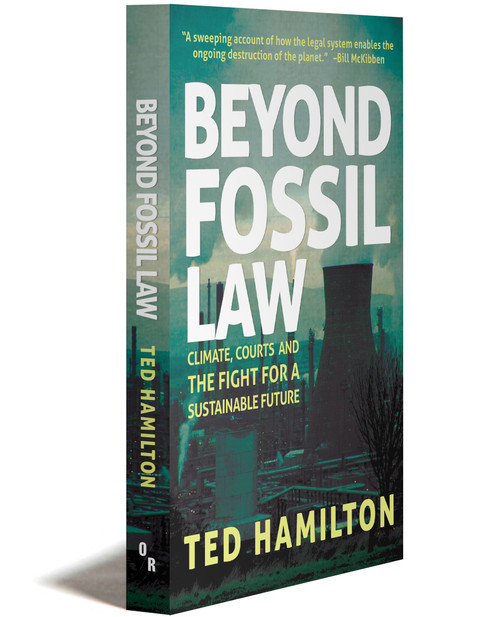Extinction (Expanded Edition)
“A welcome contribution to the growing literature on this slow-motion calamity.”
—Los Angeles Review of Books“Dawson's searing report on species loss will sober up anyone who has drunk the Kool-Aid of green capitalism.”
—Andrew Ross“Fusing social and ecological challenges to power is the only way forward … a long-awaited, elegant and comprehensive expression of why the time is right to make these links.”
—Patrick Bond“A great tool for anti-capitalists, climate change activists, and those still making sense of the intrinsic connections between the two.”
—Jasbir Puar“Historically grounded, densely researched, fluidly written … a powerful and painful exploration of human civilization's environmental irrationalities.”
—Christian Parentiabout the bookabout
Some thousands of years ago, the world was home to an immense variety of large mammals. From wooly mammoths and saber-toothed tigers to giant ground sloths and armadillos the size of automobiles, these spectacular creatures roamed freely. Then human beings arrived. Devouring their way down the food chain as they spread across the planet, they began a process of voracious extinction that has continued to the present.
Headlines today are made by the existential threat confronting remaining large animals such as rhinos and pandas. But the devastation summoned by humans extends to humbler realms of creatures including beetles, bats and butterflies. Researchers generally agree that the current extinction rate is nothing short of catastrophic. Currently the earth is losing about a hundred species every day.
This relentless extinction, Ashley Dawson contends in an expanded and revised primer that combines vast scope with elegant precision, is the product of a global attack on the commons, the great trove of air, water, plants and creatures, as well as collectively created cultural forms such as language, that have been regarded traditionally as the inheritance of humanity as a whole.
This attack has its genesis in the need for capital to expand relentlessly into all spheres of life. Extinction cannot be understood in isolation from a critique of our economic system. In this newly expanded edition, Dawson argues that decolonizing conservation demands the acknowledgement of Indigenous and local people as the true stewards of global biodiversity. To achieve this we need to transgress the boundaries between science, environmentalism, and radical politics. Extinction: A Radical History performs this task with both brio and brilliance.
About The Author / Editor
Preview
Worse still, in 2018 a new report by the WWF revealed that 60 percent of mammals, birds, fish, and reptiles have been wiped out since 1970. But it is not just that quite unfathomably large numbers of specific species are at risk of annihilation. What these studies showed is that even when species are not threatened with extinction, their numbers are often dropping precipitously. What we’re losing, in other words, is not just the diversity part of biodiversity, but the bio part as well. Even viewed in terms of sheer quantity, life on this planet is being liquidated at unprecedented rates. From the citizen scientists of Krefeld to the foremost academic experts, a grim alarm was being raised: the annihilation of wildlife is an emergency that now threatens human civilization.
But who or what is responsible for this crisis? One of the things that catalyzed me to write my book on extinction was the impression circulating in much public discourse at this time that human beings in general were responsible for the biodiversity crisis. Reading dominant news coverage of the biodiversity crisis as well as many scientific reports, one got the impression that human beings are like a plague of locusts, descending on pristine natural environments, stripping them bare, and then moving on, leaving nothing but barren earth in our wake. It seemed that there is something intrinsic to the human condition, perhaps as a result of our long evolutionary history as a species, that drives us to exploit the natural world in a completely unhinged manner. Or, in a more moralistic vein, that human beings are innately greedy and destructive. This analysis needed to be challenged, it seemed to me, since it was likely to induce political paralysis. After all, if human beings are inherently and immutably bent on plundering nature, why bother to fight against ecocide?
But beyond these questions of hope and political agency, dominant articulations of the biodiversity crisis also seem to me to be extremely racist and remarkably ahistorical. It is not humanity in general that is responsible for the crash of biodiversity: many Indigenous people, forest-dwelling peoples, and peasants around the world have existed for millennia in a remarkably balanced, even symbiotic, relationship with the natural world. In addition, historical analysis—including many of the studies I mentioned above—shows that extinction rates only really ticked up significantly during the period of European colonial expansion after the fifteenth century, increased markedly again following the Industrial Revolution, and then exploded during the so-called Great Acceleration after 1945. In other words, the biodiversity crash is a product of the intertwined forces of colonialism and capitalism. As I put it in my book, “by wrenching specific elements out of the complex ecosystems in which they are intertwined and turning them into commodities, capitalism remorselessly breaks down the natural world into impoverished but exchangeable forms, simultaneously discarding all those elements that don’t appear to have immediate exchange value.” The brutal contradictions of a capitalist system based on ceaseless, feckless expansion on a finite natural resource base are apparent in the woods, the streams, the trees, and the oceans as the planet and its precious, multitudinous life forms endure the Sixth Extinction.
in the media
Extinction (Expanded Edition)
“A welcome contribution to the growing literature on this slow-motion calamity.”
—Los Angeles Review of Books“Dawson's searing report on species loss will sober up anyone who has drunk the Kool-Aid of green capitalism.”
—Andrew Ross“Fusing social and ecological challenges to power is the only way forward … a long-awaited, elegant and comprehensive expression of why the time is right to make these links.”
—Patrick Bond“A great tool for anti-capitalists, climate change activists, and those still making sense of the intrinsic connections between the two.”
—Jasbir Puar“Historically grounded, densely researched, fluidly written … a powerful and painful exploration of human civilization's environmental irrationalities.”
—Christian Parentiabout the bookabout
Some thousands of years ago, the world was home to an immense variety of large mammals. From wooly mammoths and saber-toothed tigers to giant ground sloths and armadillos the size of automobiles, these spectacular creatures roamed freely. Then human beings arrived. Devouring their way down the food chain as they spread across the planet, they began a process of voracious extinction that has continued to the present.
Headlines today are made by the existential threat confronting remaining large animals such as rhinos and pandas. But the devastation summoned by humans extends to humbler realms of creatures including beetles, bats and butterflies. Researchers generally agree that the current extinction rate is nothing short of catastrophic. Currently the earth is losing about a hundred species every day.
This relentless extinction, Ashley Dawson contends in an expanded and revised primer that combines vast scope with elegant precision, is the product of a global attack on the commons, the great trove of air, water, plants and creatures, as well as collectively created cultural forms such as language, that have been regarded traditionally as the inheritance of humanity as a whole.
This attack has its genesis in the need for capital to expand relentlessly into all spheres of life. Extinction cannot be understood in isolation from a critique of our economic system. In this newly expanded edition, Dawson argues that decolonizing conservation demands the acknowledgement of Indigenous and local people as the true stewards of global biodiversity. To achieve this we need to transgress the boundaries between science, environmentalism, and radical politics. Extinction: A Radical History performs this task with both brio and brilliance.
About The Author / Editor
Preview
Worse still, in 2018 a new report by the WWF revealed that 60 percent of mammals, birds, fish, and reptiles have been wiped out since 1970. But it is not just that quite unfathomably large numbers of specific species are at risk of annihilation. What these studies showed is that even when species are not threatened with extinction, their numbers are often dropping precipitously. What we’re losing, in other words, is not just the diversity part of biodiversity, but the bio part as well. Even viewed in terms of sheer quantity, life on this planet is being liquidated at unprecedented rates. From the citizen scientists of Krefeld to the foremost academic experts, a grim alarm was being raised: the annihilation of wildlife is an emergency that now threatens human civilization.
But who or what is responsible for this crisis? One of the things that catalyzed me to write my book on extinction was the impression circulating in much public discourse at this time that human beings in general were responsible for the biodiversity crisis. Reading dominant news coverage of the biodiversity crisis as well as many scientific reports, one got the impression that human beings are like a plague of locusts, descending on pristine natural environments, stripping them bare, and then moving on, leaving nothing but barren earth in our wake. It seemed that there is something intrinsic to the human condition, perhaps as a result of our long evolutionary history as a species, that drives us to exploit the natural world in a completely unhinged manner. Or, in a more moralistic vein, that human beings are innately greedy and destructive. This analysis needed to be challenged, it seemed to me, since it was likely to induce political paralysis. After all, if human beings are inherently and immutably bent on plundering nature, why bother to fight against ecocide?
But beyond these questions of hope and political agency, dominant articulations of the biodiversity crisis also seem to me to be extremely racist and remarkably ahistorical. It is not humanity in general that is responsible for the crash of biodiversity: many Indigenous people, forest-dwelling peoples, and peasants around the world have existed for millennia in a remarkably balanced, even symbiotic, relationship with the natural world. In addition, historical analysis—including many of the studies I mentioned above—shows that extinction rates only really ticked up significantly during the period of European colonial expansion after the fifteenth century, increased markedly again following the Industrial Revolution, and then exploded during the so-called Great Acceleration after 1945. In other words, the biodiversity crash is a product of the intertwined forces of colonialism and capitalism. As I put it in my book, “by wrenching specific elements out of the complex ecosystems in which they are intertwined and turning them into commodities, capitalism remorselessly breaks down the natural world into impoverished but exchangeable forms, simultaneously discarding all those elements that don’t appear to have immediate exchange value.” The brutal contradictions of a capitalist system based on ceaseless, feckless expansion on a finite natural resource base are apparent in the woods, the streams, the trees, and the oceans as the planet and its precious, multitudinous life forms endure the Sixth Extinction.






